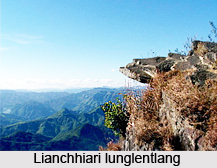Tourism in Champhai District comprises of mesmerizing natural beauty. Some of the unique yet beautiful geographical features embellish the district. Various myths and legends are also associated with different tourist sites which have further enhanced the popularity of the district as a tourist destination.
 Rih Dil Lake
Rih Dil Lake
Rih Dil Lake is one of the most famous and beautiful lakes of Champhai district. This heart shaped lake is 1 kilometre in length and 170 metres in width. It is believed that the lake serves as the way for the transcendence of the souls to their heavenly abode. The lake has a wondrous beauty as its water always remains clear even in the absence of any outflow or inflow of water. The lake has given rise to a number of folk tales. For visiting the lake, prior permission is required from the office of Deputy Commissioner.
Kungawrhi Puk
Kungawrhi Puk is a wide and deep hole beside a hill. It is located at Farkawn village. Myths say that the hole was once the entrance of an underground village where spirits used to dwell.
Thasiama Seno Neihna
Thasiama Seno Neihna is a plateau located on a steep hill. Its precarious projection out of the hill makes it inaccessible for man. Legends say that once a beautiful fairy known as Chawngtinleri bestowed Thasiama a gift that he will become prosperous by the multiplication of his pet, Mithun. The fairy used to guide his Mithun to this place safely where it used to calf. The fairy also protected it from tigers and other animals. However, the geography of the plateau makes it impossible for any Mithun to climb up.
 Lianchhiari lunglentlang
Lianchhiari lunglentlang
It is a famous cliff projected outwards from a mountain. The cliff is a nature`s wonder and attracts a plethora of tourists towards this beautiful site.
Fiara Tui
Fiara Tui, a source of water, is another popular tourist spot of Champhai district. This water come from the mountain named Tan tlang. Myths say that in olden days the people of this region had to travel long distances in search of drinking water. Fiara, the son of a poor widow, once turned a flat stone and surprisingly found a source of clear water. Initially it was the secret of Fiara and his mother but was later discovered by the villagers as a better and sweeter source of water.
Mangkhaia Lung
Mangkhaia Lung is a massive memorial stone having engravings of human figures. These figures were considered to be the guardians of the dead. Adjacent to this, other smaller structures also stand with animal and human figures engraved on them.
 Lamsial Puk
Lamsial Puk
Lamsial Puk is a cave located in Farkawn village of Champhai District. The cave once furnished a large mass of skeletons. Historical records suggest that the cave had witnessed a gruesome war between two villages where numerous warriors were killed. Many of the warriors were buried alive inside the cave. The dead bodies of the warriors belonging to Lamsial village were also kept inside the cave.
Sikpui Lung
It is stone platform which serves as the stage for dancing and singing during the Sikpui festival. Hmar community of the district celebrate this festival every year since ages.
Mura Puk
Mura Puk is an assembly of six caves situated in Zote village. These caves were believed to be a hiding place for the villagers from being attacked by Mura, a gigantic eagle, for food.
Tourism in Champhai District, apart from possessing wondrous natural beauty, is also the narrative of various historical events. Culture prevailing among the local folks of the district can also be understood by taking a tour around the district. Unique tourist sites of Champhai district greatly add to the natural heritage of India.



















